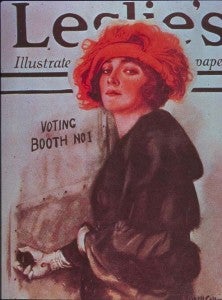The 2012 Presidential Election day is finally here, one day to go. But don’t fret, there is still time to get your students interested in the election! One of the important themes in any election is that of perspective and point of view. Developing the ability to recognize an author’s point of view helps students develop a critical eye in reading texts both historical and contemporary. A good example of a primary source from the Marchand Archive is this poster, “The Whole Story in a Nutshell!” from the 1888 election. It depicts both the Republican platform championed by Benjamin Harrison and the Democratic platform headed by Grover Cleveland.
Take a moment to digest each candidate’s platform as presented by this image. Can you discern which party produced this image? What was their motive for producing this campaign ad? How do you know? Asking students these and other questions related to point of view and purpose (detailed in the Common Core Reading Standards for Literacy in History/Social Studies RI6) will help them better analyze primary sources and engage with the political process today.

